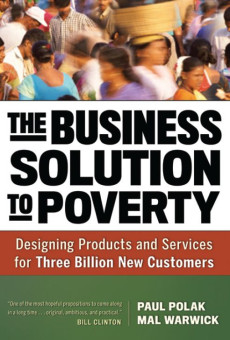
The Business Solution to Poverty: Designing Products and Services for Three Billion New Customers
Paul Polak & Mal Warwick
264 pages, Berrett-Koehler, 2013
Those of us who work in the field of poverty alleviation understand the immense challenge that we face. We have spent billions of dollars in areas such as education, health care, and microfinance, and we have improved the lives of countless people. Despite our success, however, nearly 3 billion people still live in poverty. Many nonprofits are having real impact, but few of them have the resources to do so on a truly global scale.
In The Business Solution to Poverty, Paul Polak and Mal Warwick present an alternative to relying primarily on the work of nonprofits. “Conventional approaches to end poverty have largely failed, and as Einstein taught us, to continue believing they’ll succeed would be madness,” the authors argue. The solution, they write, is to encourage businesspeople to “tap the mainstream capital markets to fund large-scale, global enterprises that address the basic needs of these 2.7 billion people.”
Polak and Warwick offer a compelling, step-by-step guide for those who want to pursue that alternative. In the book, they advocate an approach that they call “zero-based design”: Rather than adapt an existing product to make it more affordable, assume that no product currently on the market can meet the needs of the bottom 2.7 billion. “[D]etermine what poor people themselves believe will best meet their needs,” the authors write. If you haven’t talked with at least 100 customers about what they need, don’t even think about designing a solution for them.
Polak and Warwick lay out eight guidelines to follow if you want to design products that will truly alleviate poverty on a global scale. A few of them are especially noteworthy.
Design for scale from the outset | Focus from the start on bringing your product to millions—or even billions—of people. In doing so, you will naturally design a production process that allows for assembly-line replication.
Plan for last-mile distribution | To get your product into the hands of the poor, develop a strategy based on radical decentralization. Employ local people at local wages, and create a distribution network that reaches into even the most remote village.
Create aspirational branding | Recognize that the poor are discriminating buyers. Avoid traditional marketing techniques, and instead focus on using local media—Bollywood films, telenovelas, street theater—to build brand awareness.
To illustrate these guidelines, Polak and Warwick offer concrete examples of “ruthlessly affordable” products—from low-cost drip-irrigation devices to safe drinking-water systems. Many of the featured products are ones that Polak has launched, either through his nonprofit organization, IDE, or through one of his for-profit ventures, D-Rev and Windhorse International. (Warwick has an equally relevant background. He is former chairman of Social Venture Network and a co-founder of Business for Social Responsibility.)
Early in the book, the authors issue a warning: If you want to benefit from this bonanza of bottom-of-the-pyramid consumerism, be prepared to go big. If you can’t sell 100 million of your product or service in the first 10 years, then “don’t bother,” they write. That position seems unduly extreme. Setting the bar so high means that a product with the potential to reach, say, 10 million people in 10 years might never be developed—which would be a terrible loss. What’s more, the “don’t bother” principle means that multinational corporations might be the only entities with adequate resources to invest in product development at the required scale.
Do we really want multinationals to become the primary player in the poverty alleviation game? Polak and Warwick acknowledge the limits of such an approach. “A brilliant rich-country executive—or even an upper-class executive from the global South—may be totally out of his or her element working with poor people,” they write. But a company that enters this market, they argue, will have a social mission that differentiates it from most multinationals. That’s not a convincing argument, given the authors’ overall focus on the tremendous profits that await such companies.
The authors also downplay the importance of shifting the social and cultural norms that make poverty so intractable. Consider the norms that affect women, in particular. Because of age-old gender expectations, much of the world’s population remains illiterate and ill-equipped to earn a living or to help educate their children. Products designed to increase the incomes of the poor will have some impact on poverty levels, but they won’t change the norms that keep girls out of school and women confined to their homes. Nonprofits, civil society organizations, and governments are making real progress in this area.
The chance to make further progress is what motivates me in my own work. The best “solution to poverty,” in my view, will involve a combination of nonprofit work and business enterprise. Perhaps in the next edition of this book, the authors will explore how people in both sectors can work together to tackle the challenge of poverty.
Polak and Warwick, to their credit, have proven that businesses can generate sizable profits by meeting the needs of the poor. Let’s hope that this book finds its way into the hands of CEOs who will seize this opportunity—not only because it will make money, but also because it’s the right thing to do. In both of those fronts, the authors show, the opportunity “is simply too big to overlook.”

